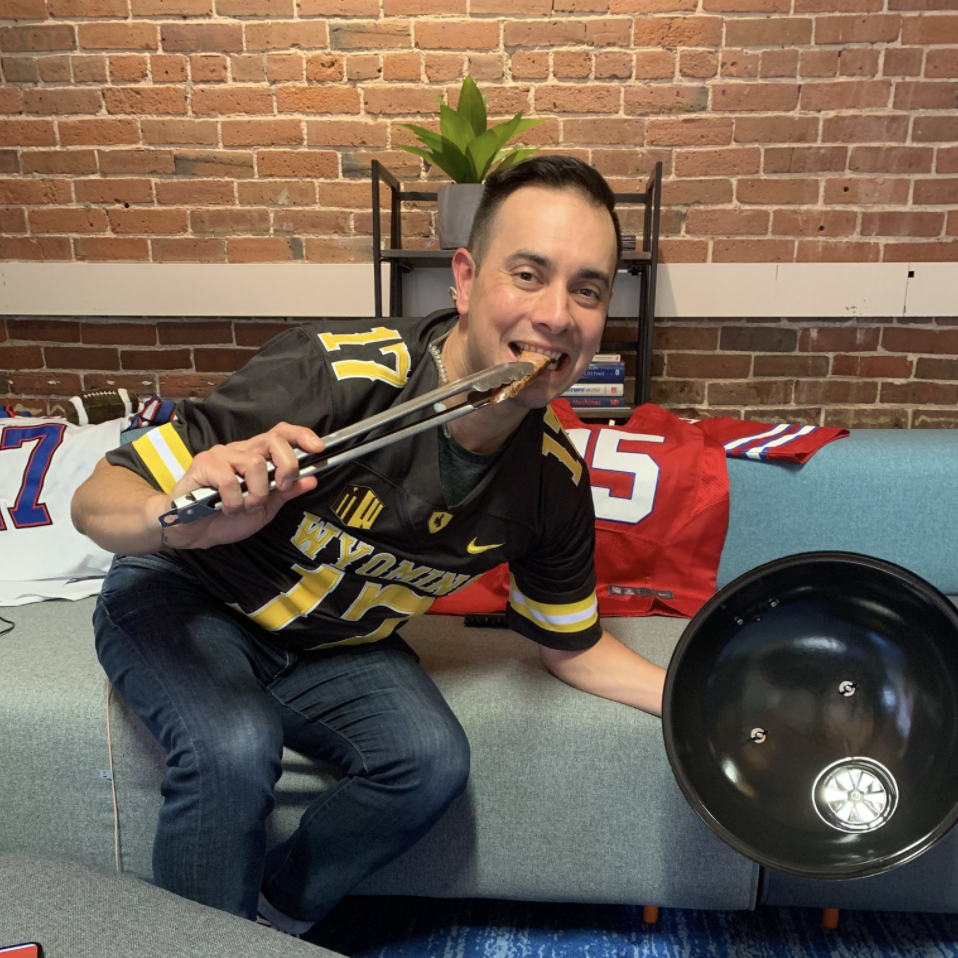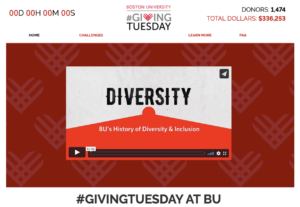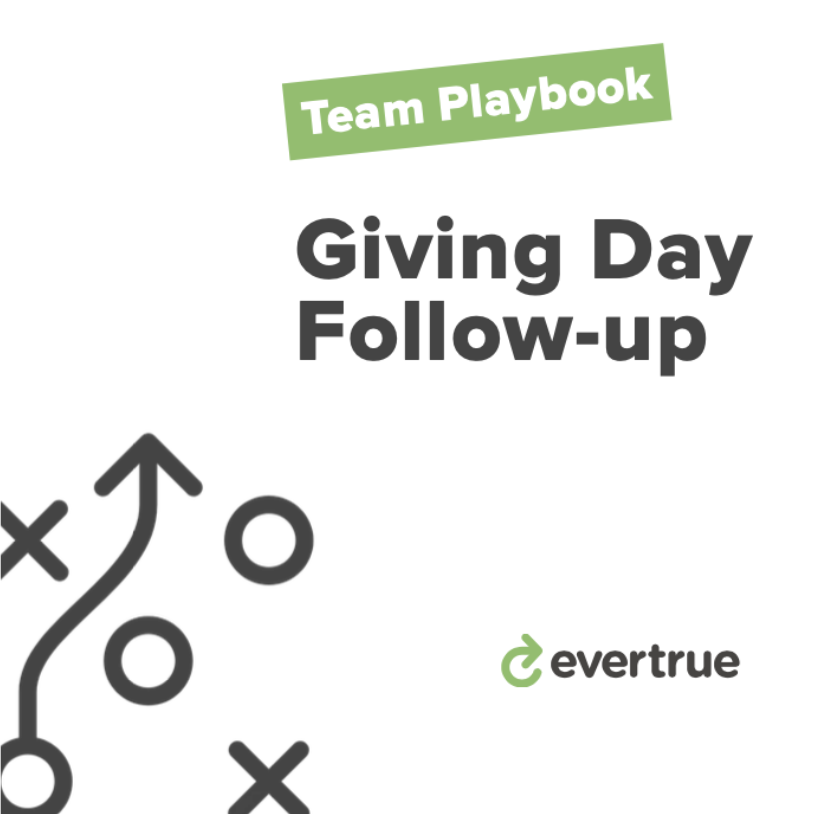A giving day isn’t the Super Bowl. It’s the first game of the season.
Giving Tuesday is just around the corner. And with strong marketing, you’re going to acquire a bunch of new donors, you’ll build up a culture of philanthropy on campus, and you’ll rally the community for a day. When the whole campus speaks, it breaks through the noise and captures the mindshare of your alums.
Which is amazing! But, it’s not the end goal.
Resources:
It’s time for kickoff.
With Giving Tuesday coming up, many advancement teams are doing an amazing job at rallying their advancement colleagues and partners across campus to get on board. Your communities are coming together with a cohesive, motivational message that reminds alums about the world-changing magic that happens on campus every day.
But the results of this all-in, cross-campus effort will fall short if you and your team don’t start planning now for ways to carry that spirit and momentum beyond that 24-hour period.
Any giving day is a chance to drive up donor retention, uncover new major gift prospects, and remind your alumni that you’re worth their attention throughout the entire year.
Here are some of our best plays to make sure you turn every single Giving Day donor from a bandwagon fan to die-hard supporter.
In the words of Heather Kopec, Executive Director of Annual Giving at Rice University (and formerly from University of Miami), “We should be telling the story of Giving Day all year long.”
Complete your passes.
Set. HIKE!
How specific are you with your Giving Day messaging this year?
In theory, it’s a good idea to give alums a ton of options for where their donation can go on a giving day. Your institution is doing so many amazing things – so there’s potential for a huge “menu” of designation options.
But the reality is that presenting your alums with a bunch of giving options results in a paradox of choice that can paralyze folks to the point that they never convert to donors.
Here’s an example of the power of a razor-sharp one-day focus. In 2019, The Kansas State team chose to focus their first-ever giving day on ONE incredibly specific cause: Cat’s Cupboard, an on-campus food pantry that helps battle food insecurity amongst students.
Simplifying their Giving Day ask allowed K-State to develop and release educational content that not only promoted the day itself, but shed light on a serious issue on which donors could have an immediate impact. It also gave fundraisers material to dive deep on the topic with donors leading up to the day, which moved forward some “stuck” prospects.
By narrowing in on the impact of their giving day, K-State raised over $320,000 from over 1,400 donors.
Boston University also embraced a singular focus for their Giving Tuesday in 2020, and there are lots of lessons to learn from them. Fran Peguero and the BU Annual Giving team walked the walk last year by aligning their Giving Tuesday fundraising efforts with their community’s passion. They identified designations across their schools and colleges that focus on promoting and celebrating Diversity, Equity, and Inclusion (DEI) at BU (i.e. the Center for Antiracist Research; the Howard Thurman Center for Common Ground; and the Black Law Students Association Scholarship Fund).
(Read more blogs about Annual Giving)
By focusing on DEI programs on Giving Tuesday, BU made the world a better place AND they grew their donor base. Wins, all-around.
Don’t wing it. Get specific with impact.
Narrowing your Giving Day focus aligns with the immediacy of a one-day, all-in fundraising push, and it lends itself to a focus on Giving Day impact.
Lots of donors make nominal gifts on Giving Day, and the beauty is that the aggregate effort really does move the needle at your institution.
(Read more blogs about Major Gifts)
Celebrate every single one of your Giving Day donors as if they were major gift donors. Even at the smallest gift levels, your donors are trusting your institution to solve issues that they care about. Show them that you’re worth that trust by being prepared to demonstrate immediate impact after Giving Day.
Here’s how.
Prior to your Giving Day, have students from featured centers and programs record ThankView videos. Queue up these videos to send in batches to donors throughout (and after) Giving Day.
A quick “Thank you so much for giving to this center! Here’s what I love most about this center as a student…” will put a face to the designation and show your donors an example of exactly the type of person that their investment is supporting.
We love to look to Williams College for impact inspo. Here are some examples of how it’s possible to get super-specific about gift impact, even for small, unrestricted gifts.
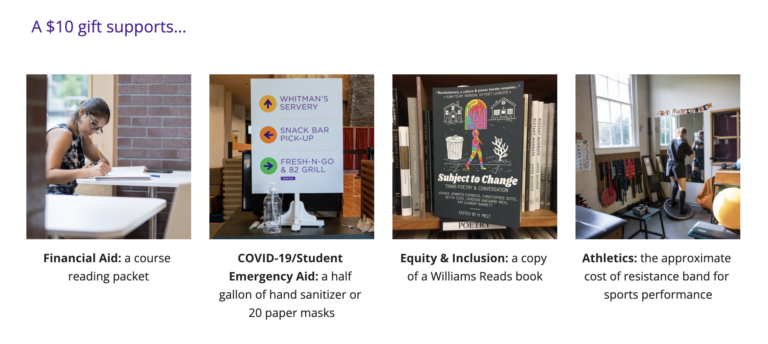
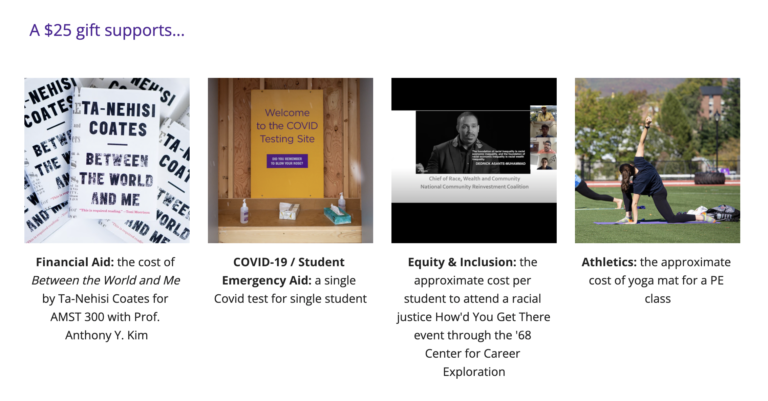
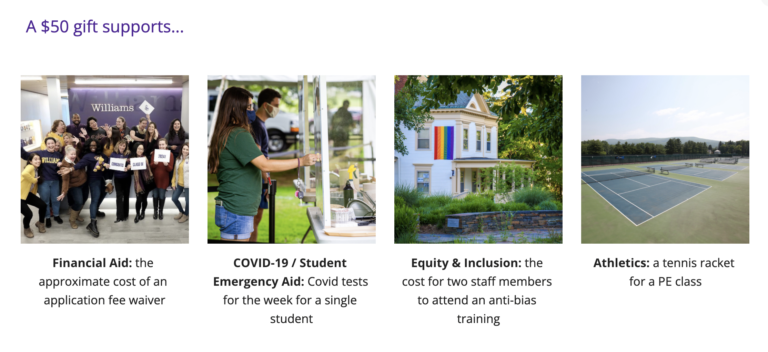
Coach up your rookies.
With great messaging and lots of social buzz, you’re going to acquire a lot of new donors on your Giving Day.
Which is great! But, how do you get those new bandwagon donors to be die-hard fans?
Nora Clark did an excellent job of welcoming new or long-lapsed donors into the donor fam when she was at Florida State University. Right after Giving Day, she sent donors a ThankView to introduce herself as the coordinator of Giving Day (aka the mastermind behind the scenes).
She wanted to humanize the Giving Day process for donors, show that there is a real live person behind it all, and give donors the chance to provide feedback on why they gave and how Giving Day could be better in future years.
Her video got responses from twelve new donors. Nora DIY-ed a mini-portfolio and built a nurture cadence to keep in touch with these twelve folks.
The takeaway here is that people like talking to people! Send all of your Giving Day donors an “intro” video from your Giving Day mastermind, ask for their feedback, and then keep in touch with new and long-lapsed donors who engage with you. It’s a great way to turn rookie donors into life-long loyal ones.
Substitution: Share the load.
Giving Days are a lot of work. Just as the folks in charge need to bring in external and internal champions to build awareness and buzz leading up to the big day, they also need to delegate follow-up so that every donor can get proper thanks and celebration.
Here’s an example of delegation at its best. At Williams College, Laura Day, Director of Annual Giving, gets the whole advancement staff involved in sending 1-1 messages of thanks to Williams donors. It’s a smart way to expose other advancement colleagues (gifts & records, stewardship, advancement services) to the joy of speaking directly with alums. And by sharing the heavy load of immediate follow-up, more donors hear “thanks!” more quickly from an actual human.
At the College of Charleston, Jenny Alstad, Senior Director of Prospect Development and Strategy, also did a great job of sharing the love. She’s part of a small advancement team, so prepping, soliciting, and following up with donors for their annual day of giving – CofC Day – is a heavy lift.
To help share the burden, Jenny recruits over 90 faculty volunteers to solicit donors on CofC Day. She assigns them each flexible “portfolios” of about 20 alums each using Volunteer by EverTrue. She uploads suggested email and phone scripts directly into the Volunteer platform, and she keeps a healthy air of competition going throughout the day by sharing metrics of who’s made the most calls, who’s closed the most gifts, and who has the best outreach-to-gift ratio.
It’s no surprise that CofC had one of its most effective and successful years of volunteer fundraising in 2021. Over 25% of faculty volunteer outreach resulted in gifts, and those gifts accounted for 10% of the total raised on CofC Day.
That’s a really strong ROI.
Advancing down the field: Keep in touch.
Giving day donors are a unique constituency. They are folks who pay attention to your school’s social media pages and on-campus ambassadors, and they’ve proven that they’re motivated by an all-in effort to solve a problem through your school.
Especially for the newly-acquired donors or the donors who only give annually on Giving Day, there is a really useful message here: if (and only if) you break through the noise, these folks will listen. And they’ll give.
So, after Giving Day, you have to make a plan to keep breaking through the noise.
(Related: Giving Day Follow-Up Playbook)
To do this, you’ll have to be politely persistent with these Giving Day donors and engage them consistently throughout the whole year. Here’s how the University of Miami is breaking through the noise and advancing their giving day donors down the field towards the end zone of deep engagement with the U.
- First, they send a ThankView video to all Giving Day donors.
- Then, they assigned all first-time donors for 1-1 outreach from Engagement Officers who asked, “Why did you give?”
- Next, they review giving day donors for additional wealth indicators and digital engagement insights.
- And finally, they assign newly rated, high-potential giving day donors to major gift officers for additional outreach.
Essentially, they add giving day donors to a nurture cadence.
Recover your fumbles
Fumbles happen!
Sometimes you manage to break through the noise and capture an alum’s attention, but it doesn’t prove enough to convert them to a donor. Or, some years your messaging reaches an alum and they give on giving day, but then you lose them the next year.
Alums who engage with your content leading up to giving day are what we call in the sales word “warm leads.” They’ve shown you that they’re interested in giving through your institution on Giving Day. The potential is there for them to be donors.
You wouldn’t leave a football resting on the field during a live play. Don’t leave digitally engaged “warm” prospects resting out there without letting them know what they’re missing out on!
Who gave on last year’s Giving Tuesday, but not this one? Who engaged digitally with content leading up to Giving Tuesday, but then didn’t give?
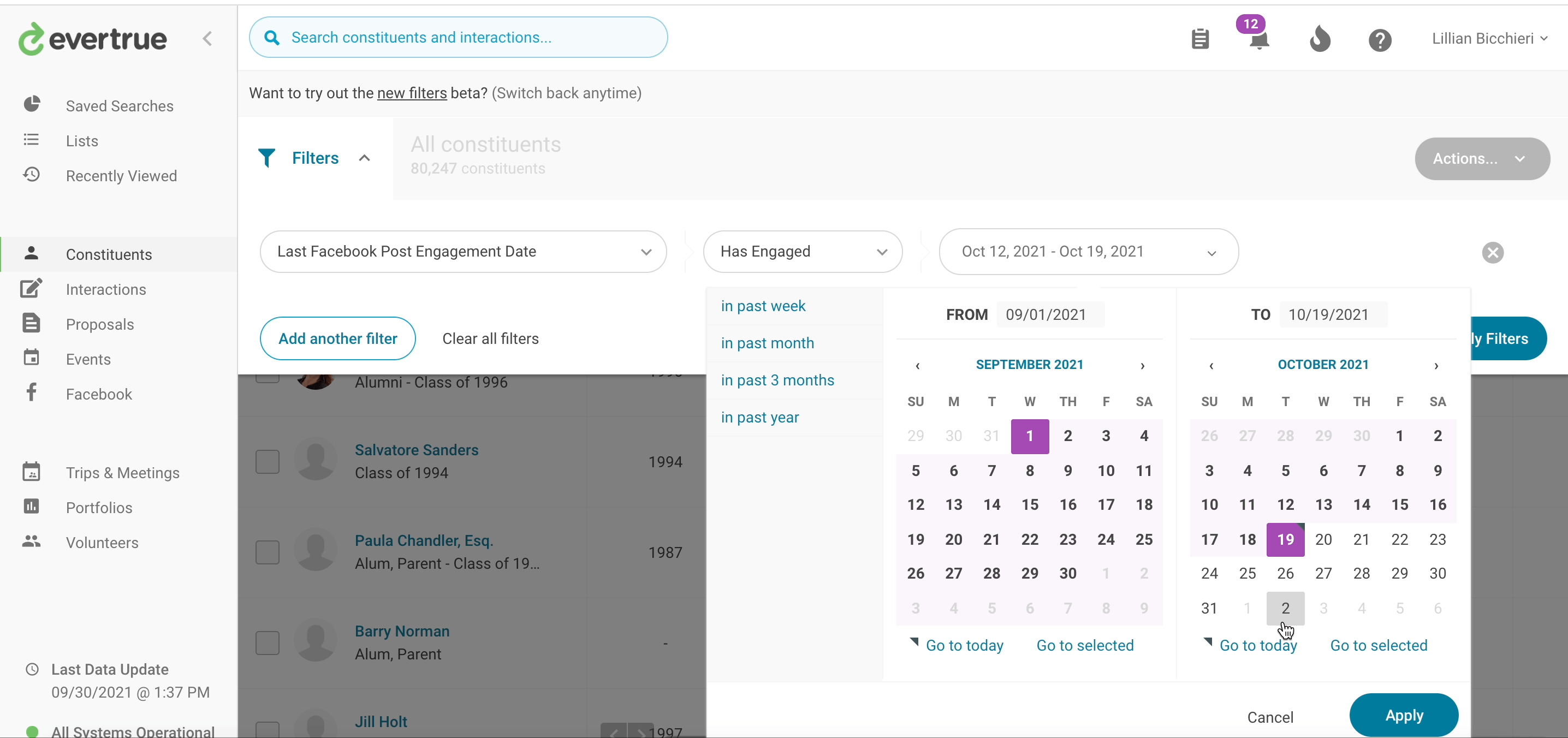
Send these folks some post-giving day content to generate a healthy sense of FOMO. Show them the problems that the community solved on Giving Day.
Make a good effort to recover your fumbles.
Huddle up! Get ready to report on ROI.
As EverTrue’s Brent Grinna reminds us, “The end of giving day should be the beginning of a new wave of major gift relationships and revenue.”
Pulling off a giving day is resource-intensive. Faculty and staff members give it lots of their time. Marketing and communication invests in promoting content digitally and around campus. Students and alumni volunteers set aside their other duties to generate buzz. And leadership oversees the budget line items that make it all possible.
So, you should be ready to report on the ROI of Giving Day to show everyone involved that this is a worthy investment.
Look at the number of Facebook engagers. Compare it to the number of Giving Day donors. Screen new donors, donors who increased their gifts, and renewed donors. Identify the number of assigned prospects who gave. Examine the number of unassigned prospects who gave.
It’s important to remember that if your giving day reporting ends a week after the event, you’re doing it wrong. At the 10, 30, 60, 90, 180, and 365-day marks, you should report out on metrics such as:
- XXX donors were highly rated prospects that were previously unassigned.
- XXX donors who were added to special stewardship portfolios.
- XXX donors who are now in discussion for larger gifts with $XXX million of pipeline.
Endzone celebration: gatorade showers.
Just as you have to steward your donors to deepen their engagement with your institution, you have to steward the teammates who make it happen (so that they can help to make it happen again next year!).
Think of the heroes of Giving Day, like your advancement services, marketing & communications, and gifts & records colleagues. Write to leadership to highlight their hard work, and give a nod to some of your star unsung heroes. It will go a long way.
Make sure to acknowledge your campus partners/giving day “influencers,” too. Send THEM a personalized ThankView as a “thank you” for THEIR ThankViews.
Heather Kopec really understands the value of team stewardship at the U.
Your Team Playbook
We work with hundreds of higher education partners around the country. Some acknowledge Giving Tuesday. Most hold giving days. Some have multiple days of giving.
Some raise hundreds of millions, others raise thousands, and everyone is trying to figure out the best ways to reach the most donors and raise the most support for their amazing institutions.
We’ve compiled some of the best follow-up strategies into a Team Playbook for Giving Day Follow-up. Be sure to let us know how it goes!
Register for our webinar series to catch more webinars like this, or subscribe to the RAISE blog for regular updates.
